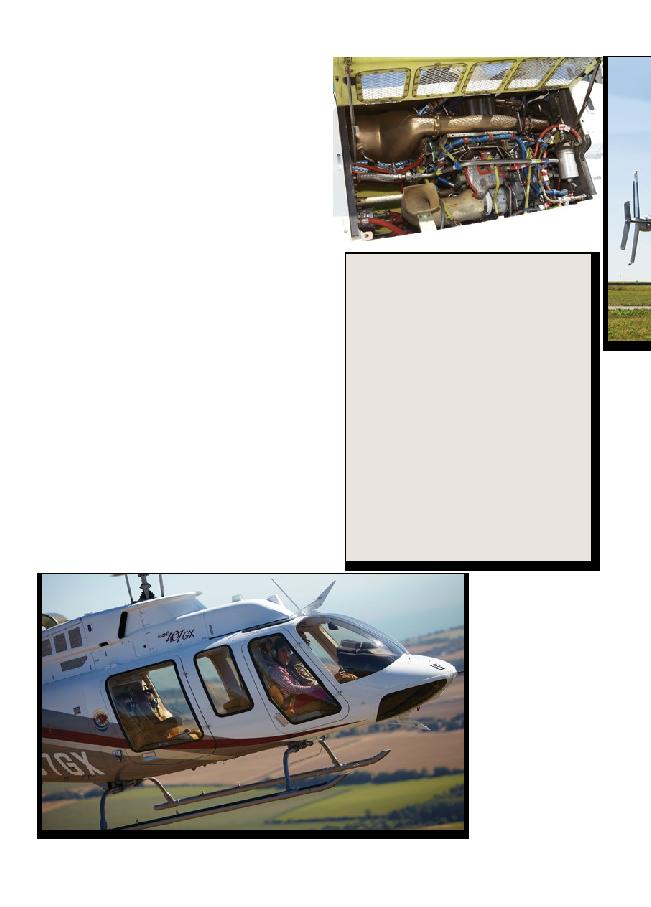
54
GA
/ Vol. 5 / No.9 / SEPTEMBER 2013
and with no increase in torque or
any feeling of `weakness' in the
machine. It was a nice feeling.
Back into normal flight and we
positioned for an autorotation to a
hover recovery. The Bell 407 does
descend quite fast, we went down
at 2500 fpm, and there was a much
greater sensation of ground rush
than there is in the more benign
Bell 206. The Bell 407 is a heavier
machine with greater drag and
four blades. Changing the rpm in
the descent did have a noticeable
effect on the rate of descent, and
reduced it to below 1000 fpm.
We flared at about 60 80
feet above the ground and the
machine slowed and stopped
beautifully, with a nice, controlled
recovery back into the hover. We
did not go to the ground as we
were not `at home' and insurance
costs and other factors often
make that the case nowadays.
We then moved on to testing
the hydraulics. Closing off the
hydraulic switch I was ready
to immediately reduce the
speed but Aimé said, "wait, if
you use small inputs it makes
the machine perfectly easy to
control even at 120 knots."
He was, of course, absolutely
correct and this is something I
have subsequently practiced with
my students in the R44 and Bell
206. Small movements worked
beautifully, even at 120 knots
and as long as I did not move
the stick violently there was
none of the familiar hydraulic-
off `stonewall' resistance.
We then slowed the machine
continuing to use very small
inputs and saw that it was
controllable right onto the ground,
even with a less muscled pilot,
Bell 407GX Specifications
Empty weight: 2,754 lbs
Gross weight: 5,000 lbs
External load gross weight 6,000lbs
Max external load 2,646 lbs
Cruise speed sea level ISA
Standard fuel 121 knots
Range (as above) 326 nm
Max cruise speed 132 knots
Endurance 3.7 hours
Engine Rolls Royce 250-C47B
with Full Authority Digital
Electronic Control
Take-off Hp 813 SHP
Max continuous 701 SHP
Fuel Capacity
Standard tanks 127.8 US gals
Auxiliary 19.0 US gals
IGE hover ceiling ISA/sea level 19,200 feet
OGE hover ceiling ISA/sea level 17,600 feet
assigned a height and direction
on the FADEC, pop up on the
Garmin screen. By holding the
helicopter sights inside the boxes
it is possible to use them as an
instrument method of flying. It is
a very good test of the accuracy
of your flying and you can
monitor the other traffic on the
screen. However, it is not a bad
idea to have someone also on the
lookout if things get very busy.
For those who get bored of
putting in frequencies by hand there
is an audio box so you can talk to the
B407 and it will change frequency
for you. The one caveat here is that
it needs to be about to understand
your accent and there were some
difficulties with regional accents.
An English teacher's joy, perhaps!
One other clever little conceit in the
machine is a `radio last transmission
recorder'. This means that if you did
not quite catch the last ATC message
using this method. Aime says
the greatest problem that pilots
have with hydraulic failure is
over-controlling the machine by
making large movements and
having to compensate for them.
In the case of a genuine
hydraulic failure, the procedure
is the same as the Bell 206: After
confirming that the switch is in
the ON position, you have to
pull the C/B in order to check
if the pressure will restore. If
so, it means that the failure is
due to the electric solenoid. If
pressure does not restore, then
push the C/B back in, turn the
hydraulic switch OFF and carry
out a precautionary landing as per
Flight Manual recommendations.
FADEC failure is something
that separates the former piston
pilots from those who learnt only
on more advanced machines. For
someone used to playing with the
throttle the lack of full automation
is not the disaster it is for turbine-
only pilots. Once the FADEC has
failed you are back to basic flying
and need to move the throttle to
keep the RPM in the green arc.
The difference here is that while
the green arc on the H269 is fairly
large, forgiving overly enthusiastic
movements, the green arc here
is very small and the pilot does
need to be quite sensitive with
his throttle movements when
lowering or raising the collective.
However it was clearly workable
and with practice, which you
would do if you owned it, it
would become second nature.
Concentrating back on the
Garmin we decided to use the
pathway boxes to fly back to the
airfield. These are little interlinked
boxes that, once you have
We flared at about 60 80 feet above the ground and the machine slowed and stopped beautifully, with a nice, controlled
recovery back into the hover.

